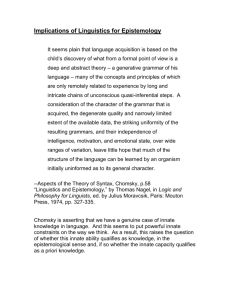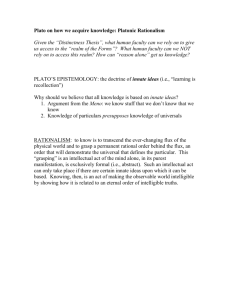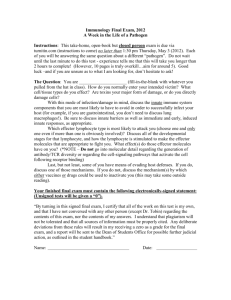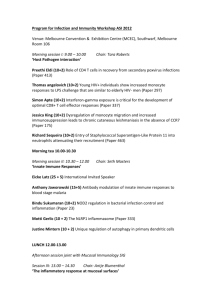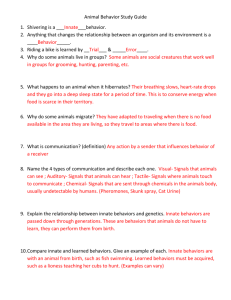tcm02 nativism - School of Informatics
advertisement
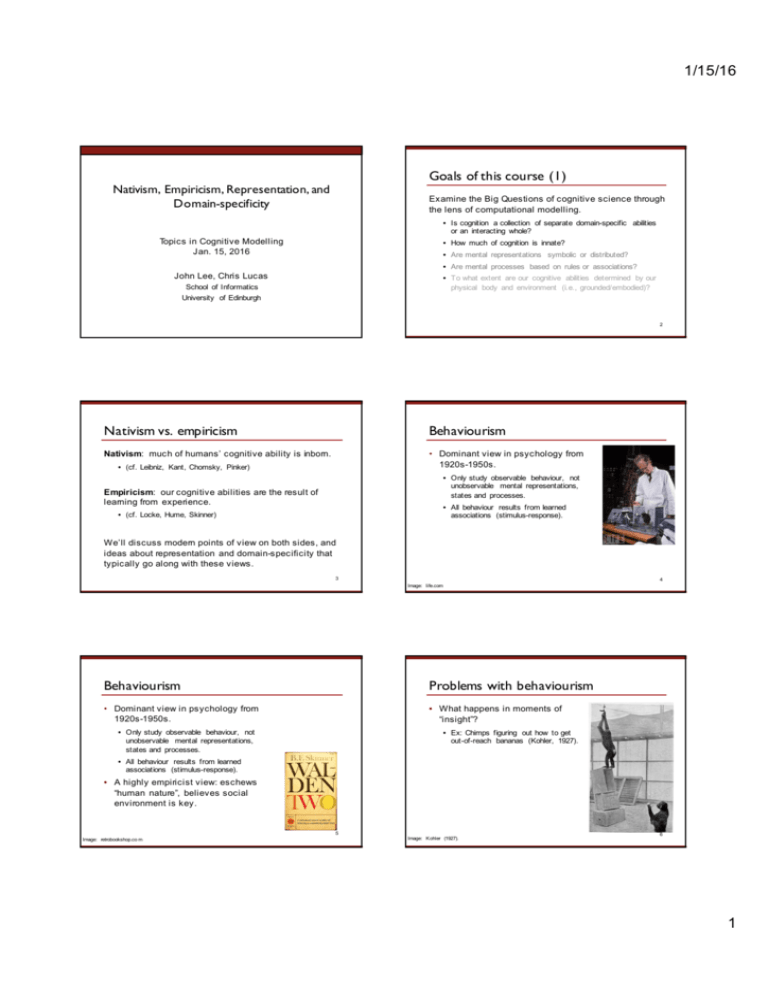
1/15/16 Goals of this course (1) Nativism, Empiricism, Representation, and Domain-specificity Examine the Big Questions of cognitive science through the lens of computational modelling. • Is cognition a collection of separate domain-specific abilities or an interacting whole? Topics in Cognitive Modelling Jan. 15, 2016 • How much of cognition is innate? • Are mental representations symbolic or distributed? • Are mental processes based on rules or associations? John Lee, Chris Lucas • To what extent are our cognitive abilities determined by our physical body and environment (i.e., grounded/embodied)? School of Informatics University of Edinburgh 2 Nativism vs. empiricism Behaviourism Nativism: much of humans’ cognitive ability is inborn. • Dominant view in psychology from 1920s-1950s. • (cf. Leibniz, Kant, Chomsky, Pinker) • Only study observable behaviour, not unobservable mental representations, states and processes. Empiricism: our cognitive abilities are the result of learning from experience. • All behaviour results from learned associations (stimulus-response). • (cf. Locke, Hume, Skinner) We’ll discuss modern points of view on both sides, and ideas about representation and domain-specificity that typically go along with these views. 3 4 Image: life.com Behaviourism Problems with behaviourism • Dominant view in psychology from 1920s-1950s. • What happens in moments of “insight”? • Only study observable behaviour, not unobservable mental representations, states and processes. • Ex: Chimps figuring out how to get out-of-reach bananas (Kohler, 1927). • All behaviour results from learned associations (stimulus-response). • A highly empiricist view: eschews “human nature”, believes social environment is key. 5 Image: retrobookshop.co m Image: Kohler (1927). 6 1 1/15/16 Problems with behaviourism Problems with behaviourism • What makes humans different from other animals and why do human universals exist across cultures? • How can learning even happen if nothing exists first? • Partial list of cultural universals compiled by D. E. Brown:* aes thetic s ; age s tatus es , terms ; anthropomorphiz ation; baby talk ; belief in s upernatural/religion; beliefs about death, fortune and mis fortune; body adornment; c hildbirth c us toms ; c hildhood fear of loud nois es ; c las s ific ation of age, body parts , c olors , fauna, flora, k in, s ex , tools , weather c onditions ; c ollec tiv e identities ; c onflic t; c oy nes s dis play ; c ry ing; c ulture/nature dis tinc tion; c us tomary greetings ; danc e; death rituals ; diurnality ; div ination; … “Except the intellect itself.” – Leibniz* • The bias-variance dilemma in statistical machine learning is a more formal statement of this problem. 7 * As quoted in Pinker (2002). “Nothing exists in the intellect that was not first in the senses.” – Locke* 8 * As quoted in Pinker (2002). The cognitive revolution Nativism in linguistics • Chomsky (1959) attacks Skinner’s book Verbal Behavior. • Chomsky’s “argument from the poverty of the stimulus”: children’s grammatical knowledge is too complex to be learned from the input they receive. • Children do not, e.g., utter “house” every time they see one: language use is stimulus-independ ent. • Ex . Hierarc hic al s truc ture v s . linear s truc ture in Y-N ques tions . • Language is infinite; children produce sentences they have never heard, apparently following complex grammatical rules (i.e., internal knowledge). I am going. Am I going? The dog is c ute. Is the dog c ute? Hy p: to form Y-N ques tion, mov e aux . v erb to front. • The start of the “cognitive revolution”: the study of the internal mind. • Additionally, Chomsky argues that much grammatical knowledge is innate. 9 Nativism in linguistics Nativism in linguistics Chomsky argues: • Chomsky’s “argument from the poverty of the stimulus”: children’s grammatical knowledge is too complex to be learned from the input they receive. • Wrong ans wer inv olv es linear s truc ture (mov e the 1 st aux ). The man who is going is here. Is the man who going is here? • Ex . Hierarc hic al s truc ture v s . linear s truc ture in Y-N ques tions . I am going. Am I going? The dog is c ute. Is the dog c ute? The man who is going is here. 10 Hy p: to form Y-N ques tion, mov e aux . v erb to front. • Correc t ans wer inv olv es k nowing that s entenc es hav e hierarc hic al s truc ture (mov e the aux in the main c laus e). [[The [man [who [is going]]]] [is here]]. Whic h aux . v erb to mov e? • This ty pe of s entenc e is not c ommon enough for c hildren to hav e heard it, y et they do not mak e errors .* Is the man who going is here? or Is the man who is going here? • Therefore, k nowledge of hierarc hic al s truc ture and relev anc e of main c laus e mus t be innate. 11 * Both of these points have been disputed more recently. 12 2 1/15/16 Theoretical assumptions What is in UG? In LAD? • A set of strong constraints on the possible forms that languages can take (Universal Grammar). UG is Basic idea: All languages follow certain principles, with certain parameters of variation. • Domain specific (e.g., refers to linguistic notions like nouns and verbs, plus much more technical ones) • Represented using symbols and deterministic rules. • An associated learning system (Language Acquisition Device) that works with UG to allow acquisition of particular languages. 13 Princ iple A: A reflex iv e pronoun mus t hav e a higher antec edent in s ome domain. The domain parameter: Option (a): domain = the s malles t c laus e c ontaining the reflex iv e pronoun. Option (b): domain = the s entenc e c ontaining the reflex iv e pronoun. Reflex iv e pronoun: hims elf, hers elf, etc . Antec edent: the thing the pronoun refers to. 14 What is in UG? In LAD? Nativism in other domains Basic idea: All languages follow certain principles, with certain parameters of variation. Spelke (1994) presents a nativist view of development in other domains. Princ iple A: A reflex iv e pronoun mus t hav e a higher antec edent in s ome domain. Claims that “core knowledge” of physics, psychology, number, and geometry is innate. The domain parameter: Option (a): domain = the s malles t c laus e c ontaining the reflex iv e pronoun. Option (b): domain = the s entenc e c ontaining the reflex iv e pronoun. •E.g., Contact principle for physics: an object can only affect the motion of another object through contact. Domain-specific: does not apply to animals. Parameters are set based on observed input data. Various specific algorithms have been proposed, often based on “cues” or “triggers”, specific types of sentences that indicate specific parameter settings. 15 Infant knowledge of physical laws 16 Infant knowledge of physical laws An experiment: • If a principle is innate, very young children should be surprised by seeing it violated. • Looking-time studies: 1. Habituate (bore) children with one display. Habituation 2. Compare time they look at two new displays: Superficially different Violates principle a. Violates principle but looks similar. b. Obeys principle but superficially different. 17 Image: Spelke, 1994 18 3 1/15/16 Infant knowledge of physical laws Spelke’s nativism: Results: Similar assumptions to Chomsky: • Innate knowledge is domain-specific. •Infants look longer at violations of continuity than violations of inertia (objects changing paths) • E.g., law of c ontac t refers only to phy s ic s of objec ts . • Innate knowledge is about fundamental properties of the world that are not necessarily perceptually salient or even possible to perceive. •At the same time, infants reach predictively in accordance with inertia. Similar arguments to Chomsky: Spelke’s interpretation: • Sophisticated early knowledge without much experience indicates innateness: “it just wouldn’t be possible to learn X based on the input received.” •Innate knowledge of continuity principle. 19 20 Summing up Connectionism Strongly nativist researchers assume • A new incarnation of empiricism, stemming from AI research in the late 70s/early 80s. • Many basic cognitive functions (perception, reasoning, language, etc.) rely largely on innate knowledge. • This knowledge is domain-specific, generally using symbolic representations. • Learning processes are also domain-specific, though many nativists don’t actually say much about learning, focusing more on what is not learned. • The beginning of the “statistical revolution” in machine learning, moving from rule-based to statistical algorithms. • Artificial neural networks show promise as robust and successful method for learning from data. • In machine learning, research on ANNs and their descendants continues as a practical technique. • Sometimes assume strong modularity: different parts of the brain are responsible for different functions, and internal workings of modules are opaque to each other. • In cognitive science, use of ANNs is typically part of a philosophical view: connectionism. 21 22 Rethinking Innateness (Elman et al., 1996) Artificial neural networks • Elman et al.’s “biologically inspired” empiricism: • ANNs reproduce what Elman et al. believe to be the critical aspects of neural structure: • Learning mechanisms and experience are more powerful than nativists believe. • Distributed computation using small computational elements. • Each element accesses only local information. • Hardware implementation (i.e., neural structure) is critical. • Information is represented in a distributed way. • Responses are nonlinear. • Evolutionary origins and environment are also important. 23 Image: entwicklungswissenschaft. de 24 Figure: http://en.wikipedia.org/wiki/Artificial_neural_network 4 1/15/16 What is “innate”? What is innate? • Elman et al.: “innate” as resulting from organisminternal developmental processes, no external input. • Elman et al. argue against innate representations based on evidence from neuroscience: • Three possible kinds of innate constraints: • Representational: e.g., principles of grammar or physics are subserved by specialized microcircuitry in the brain. • Architectural: e.g., neuron response characteristics, degree of connectivity, connections from inputs to brain regions. • Timing: e.g., order of input received, developmental changes in plasticity such as language “critical period”. • Transplant fetal tissue from somatosensory to visual cortex: transplanted tissue develops visual processing. • Rewire input signals to different brain regions: functions will change. • But happy with innate architectural and timing constraints: humans are not a completely blank slate. 25 26 Constraints in ANNs Domain-specificity • Representational: would mean fixing some weights between nodes rather than learning them. • Connectionist view on domain-specificity: • Domain-specific representations are learned. • Architectural: number of nodes and layers, connections, feedforward vs. recurrent, etc. • Domain-specific processing is learned. • Neurological arguments seem to rule out domain-specific architectural constraints, but in practice models tend to have these. • Timing: stimulus presentation order, changes in learning rate parameters, etc. 27 Summing up 28 Conclusion Most connectionist researchers assume • The brain contains powerful general-purpose learning mechanisms, so innate domain-specific representations and learning mechanisms are unnecessary. • Representations and processing are inherently distributed and statistical. Almost no researchers believe humans are a completely blank slate, arguments are about extent and nature of innate constraints. • Modern nativists: • Innate knowledge includes extensive domain-specific representations and processes. • Connectionists: • Constraints on learning result from neural architecture and timing (though many connectionists don’t talk much about constraints; leading to misunderstandings that they claim there are none). • Innate constraints arise from physical architecture and are not domain-specific. • Representation and processing are distributed and also not domain-specific. • Modularity is unlikely due to distributed representations and processing. Next time: Artificial neural networks, bias-variance trade-off 29 30 5 1/15/16 Reminders at the University of Edinburgh Browse the topics on the reading list; A survey will be circulated to pick topics and assign groups. Discovering new patterns and knowledge from data The readings themselves are password protected: Four year PhD programme U: t.......... Cours es + PhD dis s ertation (No prev ious MSc required) P: 2....... Machine learning Databases • Algorithms and systems • Statistics and optimization (For those not in class, this will be emailed) 31 Big data Natural language processing • Computer vision • Speech processing • • • • http://datascience.inf.ed.ac.uk/ References Chomsky, N., 1959. Review of Verbal Behavior, 26–58. Language, 35: Elman, J., Bates, E., Johnson, M., Karmiloff-Smith, A., Parisi, D., and Plunkett, K. 1996. Rethinking innateness: a connectionist perspective on development. Cambridge, MA: MIT Press. Kohler, W. 1927. The mentality of apes. London: Routledge & Kegan Paul. (Original work published 1917). Pinker, S. 2002. The blank slate: The modern denial of human nature. New York: Viking. Skinner, B. F., 1948. Walden Two, New York: Macmillan. Spelke, E. 1994. Initial knowledge: six suggestions. Cognition, 50, 431-445. 6
